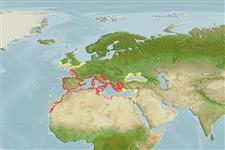>
Atheriniformes (Silversides) >
Atherinidae (Silversides) > Atherininae
Etymology: Atherina: Greek, atherina, the Greek name for the eperlane; 1770 (Ref. 45335).
More on author: Risso.
Environment: milieu / climate zone / depth range / distribution range
Écologie
marin; eau douce; saumâtre démersal; amphidrome (Ref. 59043); profondeur 1 - ? m. Subtropical; 53°N - 20°N, 18°W - 42°E
Eastern Atlantic: Portugal and Spain to Nouadhibou in Mauritania and Madeira, and throughout the Mediterranean and Black Sea. Isolated populations on coasts of England and the Netherlands (Ref. 5980). Previously, two subspecies were recognized in Russian waters: Atherina boyeri pontica (Eichwald, 1838) from the Black Sea and the Sea of Azov and Atherina boyeri caspia (Eichwald, 1838) from the Caspian Sea (Ref. 26334).
Length at first maturity / Taille / Poids / Âge
Maturity: Lm 5.8, range 5 - ? cm
Max length : 20.0 cm TL mâle / non sexé; (Ref. 30578); âge max. reporté: 4 années (Ref. 59043)
Description synthétique
Clés d'identification | Morphologie | Morphométrie
Épines dorsales (Total) : 7 - 10; Rayons mous dorsaux (Total) : 8 - 16; Épines anales: 2; Rayons mous anaux: 10 - 18. Eye diameter wider than snout length (Ref. 35388).
A very euryhaline species, where adults are frequently found in brackish waters and more sporadically in freshwater (Ref. 3788), preferring still or slow flowing waters in freshwater (Ref. 59043). They are found in lower parts of rivers, estuaries, coastal lakes and sea; pelagic in lakes (Ref. 59043). Adults occur in great schools. They are carnivorous, feeding on small crustaceans, worms, mollusks (Ref. 5980) and fish larvae (Ref. 35388) in lakes and estuaries, and on benthos in rivers (Ref. 59043). Can usually live 1 to 2 years, rarely up to 4 years. Some populations undergo spawning migrations into estuaries. Mature individuals are fractional spawners, larger individuals spawn for a longer period. Eggs are demersal, with long hairy appendages attaching them to the substrate consisting of filamentous algae, often at depths of 2 to 6 m. Larvae are pelagic often forming schools close to the shores (Ref. 59043).
Maugé, L.A., 1990. Atherinidae. p. 604-605. In J.C. Quero, J.C. Hureau, C. Karrer, A. Post and L. Saldanha (eds.) Check-list of the fishes of the eastern tropical Atlantic (CLOFETA). JNICT, Lisbon; SEI, Paris; and UNESCO, Paris. Vol. 2. (Ref. 4499)
Statut dans la liste rouge de l'IUCN (Ref. 130435)
Menace pour l'homme
Harmless
Utilisations par l'homme
Pêcheries: commercial
Outils
Articles particuliers
Télécharger en XML
Sources Internet
Estimates based on models
Preferred temperature (Ref.
123201): 13.9 - 21, mean 18.3 °C (based on 136 cells).
Phylogenetic diversity index (Ref.
82804): PD
50 = 0.5312 [Uniqueness, from 0.5 = low to 2.0 = high].
Bayesian length-weight: a=0.00575 (0.00479 - 0.00691), b=3.07 (3.01 - 3.13), in cm total length, based on LWR estimates for this species (Ref.
93245).
Niveau trophique (Ref.
69278): 3.2 ±0.36 se; based on food items.
Résilience (Ref.
120179): Milieu, temps minimum de doublement de population : 1,4 à 4,4 années (K=0.8; tm=1; tmax=4;).
Prior r = 0.57, 95% CL = 0.38 - 0.85, Based on 3 data-limited stock assessments.
Fishing Vulnerability (Ref.
59153): Moderate vulnerability (44 of 100).
Climate Vulnerability (Ref.
125649): Moderate vulnerability (44 of 100).
Nutrients (Ref.
124155): Calcium = 134 [71, 293] mg/100g; Iron = 1.07 [0.63, 1.91] mg/100g; Protein = 20.4 [19.0, 21.6] %; Omega3 = 0.34 [0.18, 0.64] g/100g; Selenium = 14.4 [6.8, 32.4] μg/100g; VitaminA = 25.1 [8.8, 69.7] μg/100g; Zinc = 1.4 [0.9, 2.0] mg/100g (wet weight); based on
nutrient studies.
